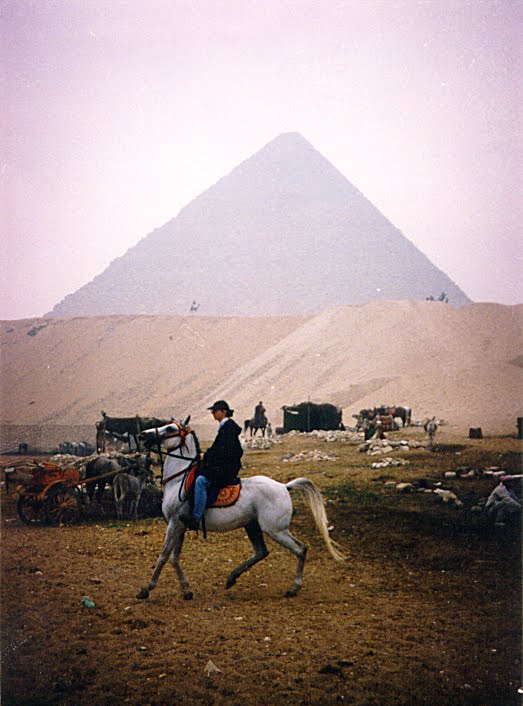
The quickest way to learn balance on a horse is to act as if there is nothing about him that you can use to steady yourself. But the horse, being a slippery and agile creature, comes these days with no shortage of artificial anchors for his balance-impaired human. With blessed relief the first thing we do upon mounting is jam our boots into the stirrups. Thus we feel grounded, no longer suspended with nothing but air beneath our feet. Imagine, for a moment, riding in an airplane where your feet don’t rest on the floor, but rather dangle freely as you sit strapped in your chair. That illusion of having our “feet on the ground” is essential to fooling ourselves into believing we are not really 30,000 feet above the ground. Same with the horse, on a somewhat smaller scale.
You have a saddle sculpted, be it Western or English, to cradle your body in precisely the center of the horse. Sit here and don’t move! Try a relative’s wedding reception with no seating cards and feel the panic of where to position your ass. If you’re lucky, your saddle is also outfitted with a balance strap or horn directly in front of you. Ah—the sturdy pole at the center of the swaying subway car! And if you need that swinging strap for extra security, there’s a beautiful mane lying right at your fingertips.
But finally, it is the horse’s most delicate feature the novice rider relies upon most to stay one with his mount: his mouth. Just how many contraptions have we invented since the domestication of the horse that involve tempering our weight against the bridge of the horse’s mouth? What countless lips and tongues have borne the untold pounds of careening human flesh behind them? Still we wonder why some horses seem to delight in reuniting us with the earth from which we sprang. I wonder only why they don’t do it more often.
I am guilty of using all these tools in the thirty-odd years I have been riding. And among the hundred or so horses I’ve had occasion to ride in that time, there have been only a handful of truly hearty protesters—two over-worked Arabians on the outskirts of Cairo and one previously abused pony here at home that we know and love as Jack. All had paid their painful dues and none deserved to bear another rider. Though the Arabians continued to work until they could be pushed no further Jack, at least, has finally earned retirement.
Lately, I have taken to leveling the playing field between Julian and me. More from laziness than goodwill in the beginning (or from a need to share his warmth in the winter months), I have left Julian’s saddle in the tack room as I bring him in from the field. At first, I still fought to cram his enormous, powerful and reluctant head into his expensive, multi-layered dressage bridle. This would go over his halter, leaving more rope and rigging on his head than might be found on your standard 19th century frigate. Then I would impress myself (or not, depending upon how many times I slid off attempting to mount as he walked calmly away) by riding without any “props.”
I was slow to realize why he hesitated to work beyond a walk. How was I to practice my balance at this pace? Sure I bounced around a bit at the trot, but I always had… the bridle… to steady myself. No wonder he only wanted to walk. 170 pounds of lurching human can’t feel good even on a draft horse’s mouth.
So off with the bridle and on with the rope halter. The first few times I rode like that the only way I could have felt less secure would have been to butter Julian’s back. Bring out the suede seat breeches! Next best thing to Velcro and no adverse effect on the horse. But over time, I felt us moving together in a way I could never feel under saddle. Finally I could feel—and identify—the placement of each foot beneath me without looking. My hips swayed in rhythm with his back, my calves there to apply pressure as his barrel swung into them. Soon we were trotting, and then cantering. And I was surprised to learn that the less I clung to his mane (Oh! so tempting!) the more in tune I was with centering my body naturally.
Horses, regardless of size, are immensely strong creatures. And no less agile (okay, maybe a little) if they are descended from draft breeds. When Julian and I take our balancing act out of the arena and into the open fields, the stakes increase for this untethered rider. Yes, there’s the helmet, but these rarely prevent dislocated shoulders or broken femurs. But as the dangers increase, so too do the rewards for relying on trust and balance rather than stirrup and bit.
And if one day I can achieve true balance out here with my horse then maybe, just maybe, I can achieve it away from the barn with both feet on the ground. And isn’t that what it’s all about? 
Wednesday, July 15, 2009
Balance
Subscribe to:
Post Comments (Atom)




No comments:
Post a Comment